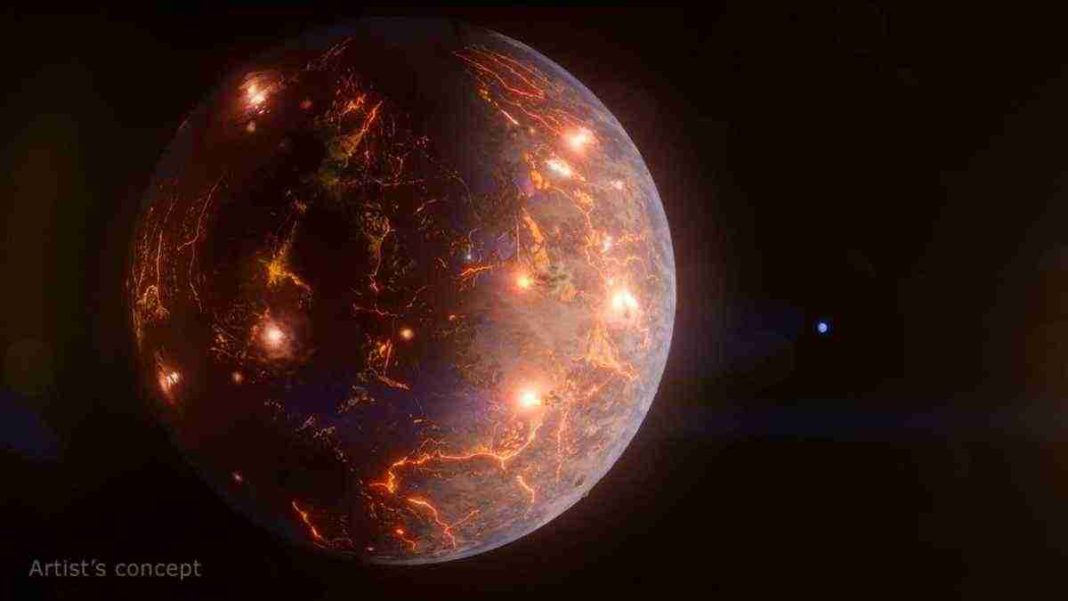UNITED STATES: In a groundbreaking discovery, astronomers have identified a potentially volcanic Earth-size exoplanet named LP 791-18 d, located approximately 90 light-years away. The planet, which resides within the southern constellation Crater, could exhibit volcanic eruptions comparable to those observed on Jupiter’s moon, Io. This finding was made possible through the collaborative efforts of NASA’s TESS (Transiting Exoplanet Survey Satellite) and the retired Spitzer Space Telescope, along with various ground-based observatories.
Merrin Peterson, a graduate of the Trottier Institute for Research on Exoplanets (iREx) at the University of Montreal, led the research that resulted in the description of LP 791-18 d in a paper that appeared in the scientific journal Nature on May 17.
Björn Benneke, an astronomy professor at iREx, who oversaw the study, explained that the planet’s tidal locking causes one side to constantly face its star, rendering the day side too hot for liquid water.
However, the researchers believe that the widespread volcanic activity occurring across the planet could potentially sustain an atmosphere, allowing water to condense on the cooler nights.
LP 791-18 d orbits a small red dwarf star and is estimated to be only slightly larger and more massive than Earth. Two other planets in the system, LP 791-18 b and c, were already known. LP 791-18 b is about 20% larger than Earth, while LP 791-18 c is more than seven times Earth’s mass and 2.5 times its size.
The unique characteristics of LP 791-18 d’s orbit bring it close to planet c during each revolution. The gravitational pull exerted by the larger planet causes the planet d’s orbit to become elliptical. Consequently, this elliptical path induces periodic deformations in planet d, generating significant internal friction that heats the planet’s interior and leads to volcanic activity on its surface—a phenomenon reminiscent of Jupiter’s influence on Io.
Located on the inner edge of the habitable zone—the range of distances from a star where liquid water could exist—LP 791-18 d raises questions about the role of tectonic and volcanic activity in supporting life.
The research team believes that the planet’s potential atmospheric conditions, coupled with geological processes, could facilitate the accumulation of crucial life-supporting materials, such as carbon, which would otherwise sink and get trapped in the crust.
The James Webb Space Telescope has already allocated observing time for planet c, and the team considers planet d an exceptional candidate for future atmospheric studies by the mission. The findings underscore the significance of ongoing research into the origins of life, both on Earth and beyond.
The Spitzer Space Telescope, which ceased operations in January 2020, contributed to the observations of the LP 791-18 planetary system. Joseph Hunt, Spitzer project manager at NASA’s Jet Propulsion Laboratory, expressed pride in the enduring impact of the mission’s data and the success achieved by the project’s engineers and scientists.
The wealth of scientific data collected by Spitzer during its active lifetime remains accessible to the public via the Spitzer data archive at the Infrared Science Archive at IPAC, Caltech.
The collaborative efforts between TESS, Spitzer, and various observatories worldwide highlight the significance of partnerships in advancing our understanding of the universe. TESS, led by MIT and managed by NASA’s Goddard Space Flight Center, involves several esteemed partners, including Northrop Grumman, NASA’s Ames Research Center, the Center for Astrophysics | Harvard & Smithsonian, MIT’s Lincoln Laboratory, and the Space Telescope Science Institute.
Multiple universities, research institutes, and observatories globally contribute to the mission’s success. As the pursuit of knowledge continues, these discoveries contribute to humanity’s expanding understanding of exoplanets and the possibilities they present for the existence of life beyond our solar system.
Also Read: NASA Set to Unveil Partner for Lunar Lander Development in Historic Artemis Moon Mission



